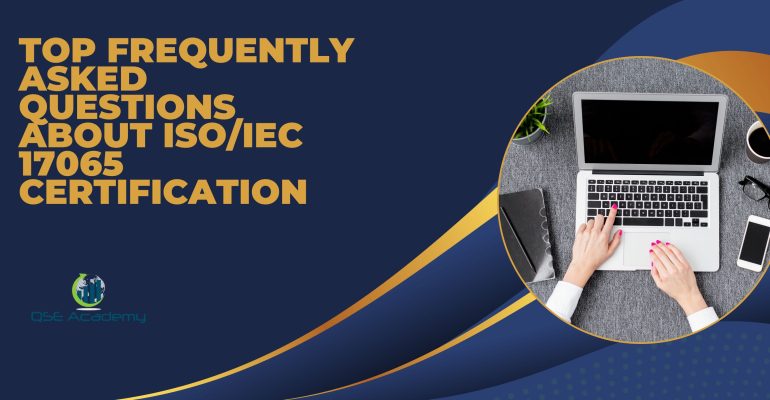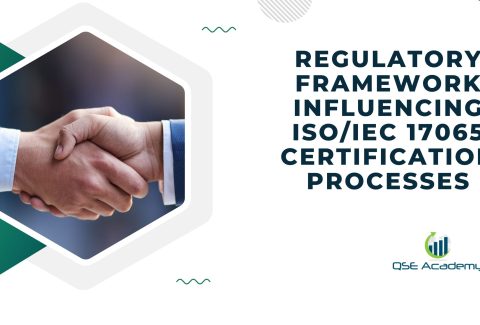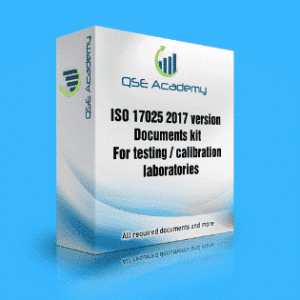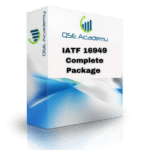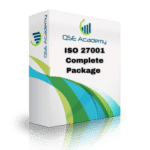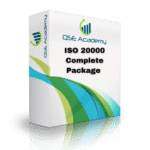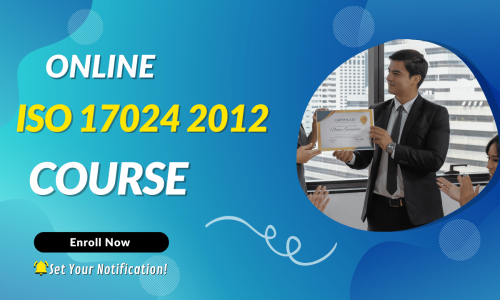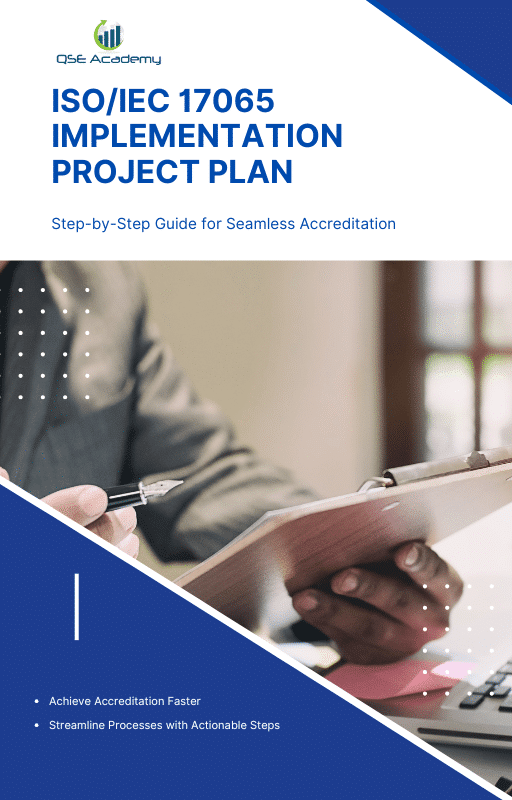Top Frequently Asked Questions About ISO/IEC 17065 Certification
Top Frequently Asked Questions About ISO/IEC 17065 Certification
If you’ve ever wondered what ISO/IEC 17065 certification is all about, you’re not alone. Many businesses and certification bodies have tons of questions about how it works, why it’s important, and what it takes to get certified. That’s exactly why we’ve put together this FAQ about ISO 17065 certification—to break it all down in a simple, no-nonsense way.
ISO/IEC 17065 might sound like just another complicated technical standard, but at its core, it’s about trust and reliability. This certification is what ensures that certification bodies—the organizations that approve products, services, or processes—are following strict guidelines and are fair, competent, and impartial. In other words, it’s what helps businesses and consumers trust that a certification actually means something.
So, if you’re a certification body looking to get accredited, a business trying to understand why this certification matters, or just someone who’s curious about the whole process, this guide will answer the most frequently asked questions about ISO 17065 certification. We’ll cover who needs it, what the requirements are, how long it takes, and why it’s a game-changer for credibility.
By the time you’re done reading, you’ll have a clear understanding of ISO/IEC 17065 and why it plays a huge role in certification processes across industries. Let’s dive into the details and answer all your burning questions!
Understanding ISO/IEC 17065 Certification
Now that we’ve set the stage, let’s get into the core of ISO/IEC 17065 certification—what it is, why it matters, and who actually needs it. If you’ve been searching for a clear and simple FAQ about ISO 17065 certification, you’re in the right place. Let’s break it down step by step.
What is ISO/IEC 17065 certification?
Think of ISO/IEC 17065 as the gold standard for certification bodies. It’s an internationally recognized standard that ensures organizations responsible for certifying products, processes, or services are doing it in a fair, competent, and impartial way.
In other words, it makes sure that when a product or service is certified—whether it’s an organic food label, an eco-friendly product, or a safety compliance mark—that certification is legitimate and trustworthy. Without ISO/IEC 17065, it would be much harder to know if a certification body is actually following best practices or just handing out approvals without proper checks.
So, if you’re a certification body, this standard is essential for proving your credibility. And if you’re a business that relies on certified products, understanding ISO 17065 certification helps you recognize which certifications are backed by rigorous, internationally accepted standards.
Why is ISO/IEC 17065 important?
Imagine if anyone could just slap a “Certified Safe” or “Eco-Friendly” label on a product without any real process behind it. That would cause chaos in industries, and customers wouldn’t know who to trust. That’s why ISO/IEC 17065 certification exists—to ensure that certification bodies follow strict procedures and that their approvals are meaningful and globally accepted.
Here’s why this certification is so important:
✅ Builds trust and credibility – Businesses, regulators, and customers rely on certifications to make informed decisions. If a certification body is ISO/IEC 17065 certified, it means their process is transparent, fair, and internationally recognized.
✅ Ensures consistency – Certification bodies must follow structured guidelines to avoid bias, favoritism, or conflicts of interest. ISO/IEC 17065 helps ensure that certifications are consistent across different industries and countries.
✅ Supports global trade – Many industries require internationally recognized certification to sell products or services in different markets. Without ISO/IEC 17065, businesses could struggle to meet global regulatory and compliance requirements.
Who needs ISO/IEC 17065 certification?
Now, here’s where it gets interesting. Not every company needs to be ISO 17065 certified—this standard is specifically for certification bodies, not for individual businesses or manufacturers.
But if your organization certifies products, services, or processes, then ISO/IEC 17065 is a must. This applies to certification bodies in industries like:
🔹 Organic and food safety certifications (e.g., organic farming, fair trade labels)
🔹 Environmental certifications (e.g., energy efficiency, sustainability ratings)
🔹 Product safety and quality (e.g., electrical equipment, construction materials)
🔹 Security and IT standards (e.g., cybersecurity certifications, data protection)
So, if your organization provides official certifications that businesses rely on for credibility, getting ISO/IEC 17065 certified is crucial. It’s the best way to prove that your certification process meets high-quality, internationally accepted standards.
This section of our FAQ about ISO 17065 certification gives you a solid understanding of what it is, why it’s essential, and who actually needs it. Up next, we’ll dive into the main requirements for ISO/IEC 17065 certification—so you’ll know exactly what it takes to get certified. Stay tuned!
Key Requirements for ISO/IEC 17065 Certification
Now that you know what ISO/IEC 17065 certification is and why it matters, let’s talk about the requirements. If you’re a certification body thinking about getting certified, you’re probably wondering: What exactly do we need to do?
That’s where this FAQ about ISO 17065 certification comes in handy. Below, we’ll break down the key requirements in a simple and straightforward way.
What are the main requirements of ISO/IEC 17065 certification?
To get certified under ISO/IEC 17065, a certification body must meet strict criteria that prove it is competent, impartial, and reliable. Here are the core areas covered by the standard:
✅ Impartiality and Independence – Certification bodies must operate fairly and without bias. This means they can’t have conflicts of interest with the businesses they certify. For example, a company can’t certify its own products—that would be like grading your own test!
✅ Competence of Personnel – The people making certification decisions need to be highly qualified. This includes auditors, decision-makers, and technical experts who understand the industry and the certification process.
✅ Transparent and Consistent Certification Process – Certification bodies must follow clear procedures so that all certifications are consistent. This ensures that a certification means the same thing no matter where or when it’s issued.
✅ Proper Record-Keeping – Every decision made during the certification process must be documented. That way, if there’s ever a dispute or question about a certification, there’s a clear paper trail to verify the process.
✅ Confidentiality – Certification bodies deal with sensitive business information, so they must have policies to protect client data and ensure that information isn’t misused.
What are the steps to achieve ISO/IEC 17065 certification?
If you’re a certification body looking to get ISO/IEC 17065 certified, here’s what the process generally looks like:
Step 1: Conduct a Gap Analysis
Before jumping into the certification process, it’s important to evaluate where you stand. This means reviewing your current policies, procedures, and systems to see how they compare to ISO/IEC 17065 requirements.
Step 2: Implement Necessary Changes
Once you’ve identified gaps, the next step is to update policies, train staff, and improve documentation to align with the standard. This may include:
- Clarifying roles and responsibilities
- Enhancing audit and review processes
- Strengthening data security and confidentiality policies
Step 3: Conduct an Internal Audit
Before applying for certification, it’s a good idea to run an internal audit. This helps catch any issues that need fixing before the external audit.
Step 4: Undergo an External Audit
An accreditation body (a recognized organization that grants ISO certifications) will review your systems and processes. They’ll check whether you meet all the ISO/IEC 17065 requirements.
Step 5: Receive Certification and Maintain Compliance
If you pass the audit, congratulations! 🎉 You’ll receive your ISO/IEC 17065 certification. But it doesn’t stop there—you’ll need to stay compliant by undergoing regular audits and assessments.
This section of our FAQ about ISO 17065 certification covers the essential requirements and steps to certification. Next, we’ll dive into the certification process timeline and challenges—because let’s be honest, every certification journey comes with a few bumps along the way. Stay tuned!
The Certification Process and Challenges
Now that we’ve covered the key requirements for ISO/IEC 17065 certification, let’s talk about the certification process itself—how long it takes, how much it costs, and some of the common challenges organizations face. If you’re looking for straightforward answers to these questions, this section of our FAQ about ISO 17065 certification has got you covered!
How long does it take to become ISO/IEC 17065 certified?
One of the first things people ask about ISO/IEC 17065 certification is, “How long will this take?” The answer? It depends.
Here are a few key factors that affect the timeline:
⏳ Readiness of the Organization – If a certification body already has well-documented policies and a structured quality management system, the process will be much faster. If not, expect to spend time making necessary improvements before applying.
⏳ Size and Complexity of the Certification Body – A small certification body with a simple structure might complete the process in a few months, while a larger, more complex organization could take up to a year or more.
⏳ Accreditation Body’s Availability – The external audit and assessment depend on the schedule of the accreditation body. Some organizations experience longer wait times depending on their region and industry.
On average, organizations can expect the entire ISO/IEC 17065 certification process to take between 6 to 12 months from start to finish.
How much does ISO/IEC 17065 certification cost?
Another big question in this FAQ about ISO 17065 certification is, “How much is this going to cost?” Again, the cost varies depending on a few factors:
💰 Accreditation Body Fees – Different accreditation bodies have different pricing structures for audits, assessments, and annual surveillance reviews.
💰 Consulting and Training Costs – If a certification body needs external consultants or training programs to meet ISO/IEC 17065 requirements, this adds to the total cost.
💰 Internal Resources – The time and effort spent by employees to update procedures, document compliance, and undergo audits should also be factored into the total investment.
💡 Estimated Costs: While costs differ by country and industry, most organizations should budget anywhere from $10,000 to $50,000 for the entire process, including initial certification and ongoing surveillance audits.
While this may seem like a big investment, ISO/IEC 17065 certification is a game-changer for certification bodies looking to establish credibility, expand globally, and attract more clients.
What challenges do organizations face in achieving ISO/IEC 17065 certification?
Getting ISO/IEC 17065 certified isn’t always smooth sailing. Many organizations run into a few common roadblocks along the way. Here’s what to watch out for—and how to overcome these challenges.
🚧 Lack of Internal Expertise – Many certification bodies struggle with understanding the technical requirements of ISO/IEC 17065. The solution? Hiring a consultant or investing in training can make the process much easier.
🚧 Complex Documentation Requirements – Keeping up with detailed records, policies, and procedures can feel overwhelming. The best approach is to set up a structured document management system early in the process.
🚧 Resource Constraints – Some organizations don’t have enough time, staff, or budget to focus on certification. The key is breaking the process into manageable steps and allocating dedicated team members to handle compliance.
🚧 Audit Anxiety – External audits can be intimidating, but they don’t have to be! The best way to avoid non-conformities is to conduct an internal audit before the official assessment. This way, you can identify and fix any weak areas in advance.
Final Thoughts on the Certification Process
If you’ve been wondering how long ISO/IEC 17065 certification takes, how much it costs, and what challenges to expect, this section of our FAQ about ISO 17065 certification should give you a clear picture.
While the process requires time, effort, and investment, the benefits of achieving certification—stronger credibility, compliance with international standards, and increased business opportunities—make it well worth it.
Next, we’ll explore how to maintain compliance and keep your certification active, so you can continue to reap the rewards long after getting certified. Stay with us!
Maintaining and Improving Compliance with ISO/IEC 17065 Certification
So, you’ve made it through the ISO/IEC 17065 certification process—congratulations! 🎉 But here’s the thing: getting certified is just the first step. To keep your certification active and continue benefiting from it, you need to maintain compliance and be ready for ongoing audits.
In this section of our FAQ about ISO 17065 certification, we’ll cover what happens after certification, how often you need to renew it, and what to do if something goes wrong. Let’s dive in!
How often do you need to renew ISO/IEC 17065 certification?
One of the most common questions in any FAQ about ISO 17065 certification is: “Does this certification last forever?” The short answer? Nope.
ISO/IEC 17065 certification isn’t a one-and-done deal—it requires ongoing compliance and periodic reassessments to ensure that certification bodies continue to meet the standard’s requirements.
🔄 Surveillance Audits – Most accreditation bodies conduct annual surveillance audits to check that the certification body is still operating fairly, competently, and impartially. These audits help catch any issues before they become major problems.
📆 Full Recertification – Every three to five years, certification bodies must go through a full reassessment to renew their ISO/IEC 17065 certification. This process is similar to the initial certification audit, but it also considers any updates to the standard and changes in the organization’s processes.
The bottom line? Maintaining ISO/IEC 17065 certification is an ongoing process, and organizations need to stay prepared by keeping their procedures up to date.
How to stay compliant with ISO/IEC 17065 certification
Once a certification body is ISO 17065 certified, it’s crucial to stay compliant to avoid non-conformities that could lead to suspension or withdrawal of the certification. Here are some best practices to keep things running smoothly:
✅ Regular Internal Audits – Conducting internal audits at least once a year helps identify potential weaknesses before an external audit. It’s always better to find and fix issues on your own rather than waiting for an auditor to point them out.
✅ Keep Records Updated – Documentation is a big part of maintaining ISO/IEC 17065 certification. Certification bodies should regularly update their policies, procedures, and certification decisions to ensure they remain transparent and traceable.
✅ Continuous Staff Training – A certification body is only as strong as its people. Keeping auditors and decision-makers trained on the latest ISO requirements and industry regulations ensures that the organization remains competent and compliant.
✅ Monitor Changes in ISO Standards – ISO standards don’t stay the same forever! Certification bodies must keep an eye on any updates or revisions to ISO/IEC 17065 and adjust their processes accordingly.
By following these steps, certification bodies can avoid compliance risks and ensure their ISO/IEC 17065 certification remains valid and respected.
What happens if a certification body fails an audit?
Nobody wants to fail an audit, but it happens. The good news? Failing an audit doesn’t always mean losing your certification.
Here’s what happens if a certification body receives non-conformities during an audit:
🚨 Minor Non-Conformities – If an audit finds small issues, like missing documentation or slight deviations from procedures, the certification body is usually given a deadline to fix them before their certification is impacted.
🚨 Major Non-Conformities – If the audit uncovers serious violations, such as conflicts of interest or a failure to follow certification procedures, the certification body may face temporary suspension until they take corrective action.
🚨 Loss of Certification – In rare cases, if a certification body repeatedly fails audits and doesn’t make corrections, they could lose their ISO/IEC 17065 certification. This can damage their reputation and ability to operate.
The best way to avoid audit failures is to stay proactive—conduct internal audits, address potential risks early, and ensure your certification practices remain strong.
Final Thoughts on Maintaining ISO/IEC 17065 Certification
Achieving ISO/IEC 17065 certification is a major accomplishment, but maintaining it requires ongoing effort. Certification bodies must keep up with surveillance audits, documentation updates, and continuous improvement to ensure they remain compliant and credible.
As we wrap up this section of our FAQ about ISO 17065 certification, remember: staying compliant isn’t just about checking a box—it’s about building trust and ensuring the integrity of certifications worldwide.
Next, we’ll explore some of the most frequently asked questions about ISO/IEC 17065 certification, including how it relates to other standards and whether businesses can certify themselves. Stay with us!
Frequently Asked Questions About ISO/IEC 17065 Certification
By now, we’ve covered a lot about ISO/IEC 17065 certification—what it is, why it matters, how to get certified, and how to maintain compliance. But if you still have questions, don’t worry—you’re not alone! In this section of our FAQ about ISO 17065 certification, we’ll answer some of the most common questions people ask about this important standard.
Let’s get right into it!
How does ISO/IEC 17065 relate to other ISO standards?
One of the biggest sources of confusion is how ISO/IEC 17065 fits in with other ISO standards. After all, there are so many of them!
Here’s a quick comparison to help clear things up:
🔹 ISO/IEC 17065 vs. ISO 9001 – ISO 9001 is a quality management system standard that applies to all types of businesses. In contrast, ISO/IEC 17065 is specifically for certification bodies that certify products, services, or processes.
🔹 ISO/IEC 17065 vs. ISO/IEC 17021 – While ISO/IEC 17065 focuses on certification bodies for products, processes, or services, ISO/IEC 17021 applies to certification bodies that certify management systems (like ISO 9001, ISO 14001, etc.).
🔹 ISO/IEC 17065 vs. ISO/IEC 17025 – ISO/IEC 17025 is for testing and calibration laboratories, ensuring that they provide accurate and reliable test results. In contrast, ISO/IEC 17065 certification ensures that certification bodies follow fair, impartial, and structured certification processes.
So, while these standards work together in different ways, they each have their own specific purpose!
Can a company certify itself under ISO/IEC 17065?
Short answer? No.
ISO/IEC 17065 is not something that a business can apply for to prove their own quality or compliance. Instead, it’s a standard for certification bodies—the organizations that evaluate and approve products, services, or processes.
Here’s how it works:
✅ A certification body (like an inspection or testing agency) gets ISO/IEC 17065 certified.
✅ That certification body is then able to certify products, services, or processes under different certification schemes.
✅ Businesses that want a specific certification (like organic food certification, safety approvals, or eco-friendly labels) must go through an ISO 17065-certified certification body.
So, if you’re a business looking to get a certification for your product, you don’t need ISO/IEC 17065 certification yourself—but you do need to work with a certification body that has it!
Does ISO/IEC 17065 apply to all industries?
Yes, ISO/IEC 17065 certification is used across a wide range of industries, but it’s not required for all.
Here are some of the industries that commonly rely on ISO/IEC 17065-certified certification bodies:
🌿 Agriculture & Organic Products – Certifications for organic farming, sustainable agriculture, and fair trade all require certification bodies to be ISO 17065 accredited.
🔧 Product Safety & Quality – Industries like electronics, construction materials, and automotive often require products to meet strict certification standards, which are enforced by ISO/IEC 17065-certified bodies.
🌱 Environmental & Sustainability Certifications – Labels like energy efficiency, carbon footprint certifications, and eco-friendly product approvals all require certification bodies to meet ISO/IEC 17065 requirements.
🔒 Security & IT Standards – Certifications related to cybersecurity, data protection, and software compliance also rely on ISO/IEC 17065-certified bodies to verify compliance.
While ISO/IEC 17065 certification isn’t mandatory for all industries, it plays a crucial role in ensuring that certification bodies operate fairly, accurately, and consistently across multiple sectors.
Final Thoughts on Frequently Asked Questions About ISO 17065 Certification
We’ve covered a lot of ground in this FAQ about ISO 17065 certification, but the key takeaway is this:
🔹 ISO/IEC 17065 certification is designed for certification bodies, not individual companies.
🔹 It ensures that certification bodies operate with impartiality, consistency, and transparency.
🔹 It’s used in many industries, from organic food to cybersecurity, helping businesses prove compliance and build trust.
If you’re working with certifications in any way—whether you’re a certification body or a business seeking certification—understanding ISO/IEC 17065 certification is essential.
Still have more questions? Drop them in the comments, and we’ll be happy to help!
Conclusion – Why ISO/IEC 17065 Certification Matters
We’ve covered a lot in this FAQ about ISO 17065 certification, and by now, you should have a clear understanding of what this certification is, who needs it, how to get it, and why it’s so important. But let’s take a moment to bring it all together.
If you’re a certification body, getting ISO/IEC 17065 certified is about more than just meeting requirements—it’s about building trust, credibility, and global recognition. This certification ensures that your certification decisions are impartial, consistent, and backed by an internationally recognized standard.
For businesses, ISO/IEC 17065 certification helps you identify which certification bodies you can truly trust. If you’re applying for product or service certification, working with an ISO 17065-certified body guarantees that the process is fair, transparent, and internationally accepted.
Key Takeaways from This FAQ About ISO 17065 Certification
🔹 ISO/IEC 17065 certification is essential for certification bodies that evaluate products, services, or processes.
🔹 It ensures that certification bodies operate fairly, competently, and transparently.
🔹 The process involves meeting strict requirements, undergoing audits, and maintaining compliance through regular assessments.
🔹 Businesses cannot certify themselves under ISO 17065, but they should always work with an ISO/IEC 17065-certified certification body to get legitimate product or service certifications.
🔹 Maintaining ISO/IEC 17065 certification requires ongoing audits, updated documentation, and continuous improvement.
Final Thoughts
At the end of the day, ISO/IEC 17065 certification plays a huge role in global trade, regulatory compliance, and consumer confidence. Whether you’re a certification body aiming for accreditation or a business relying on certified products, understanding this certification is key to ensuring quality, trust, and market acceptance.
Hopefully, this FAQ about ISO 17065 certification has answered your biggest questions! But if you still have more, feel free to reach out—we’re always happy to help.
I hold a Master’s degree in Quality Management, and I’ve built my career specializing in the ISO/IEC 17000 series standards, including ISO/IEC 17025, ISO 15189, ISO/IEC 17020, and ISO/IEC 17065. My background includes hands-on experience in accreditation preparation, documentation development, and internal auditing for laboratories and certification bodies. I’ve worked closely with teams in testing, calibration, inspection, and medical laboratories, helping them achieve and maintain compliance with international accreditation requirements. I’ve also received professional training in internal audits for ISO/IEC 17025 and ISO 15189, with practical involvement in managing nonconformities, improving quality systems, and aligning operations with standard requirements. At QSE Academy, I contribute technical content that turns complex accreditation standards into practical, step-by-step guidance for labs and assessors around the world. I’m passionate about supporting quality-driven organizations and making the path to accreditation clear, structured, and achievable.

